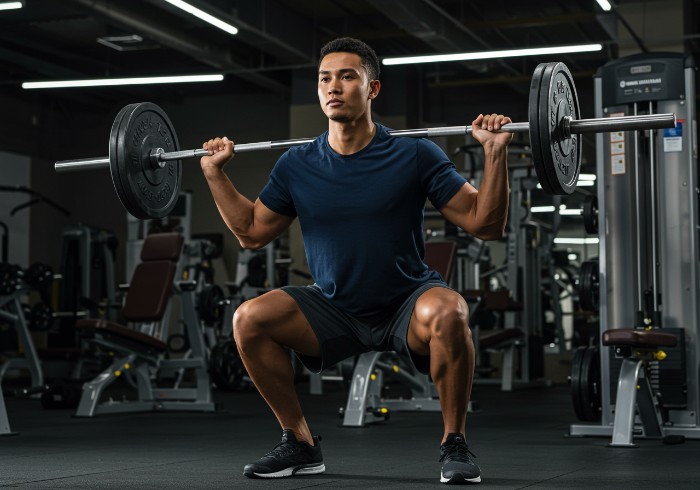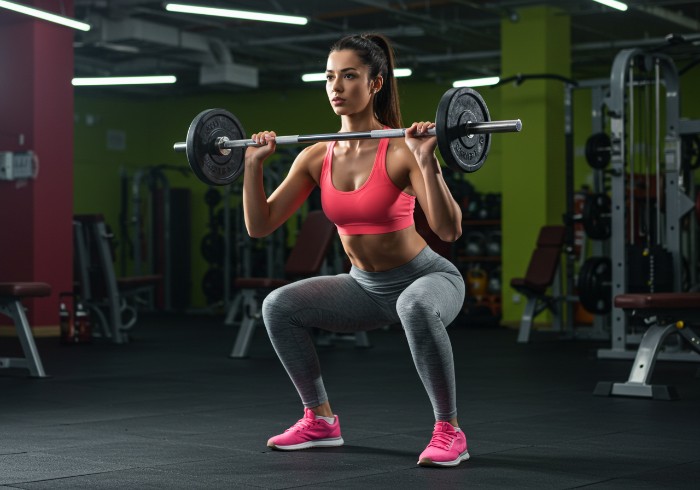You ever hear someone at the gym say, “Don’t squat too heavy—you’ll shrink!”? Yeah, I’ve heard it more times than I can count. It usually comes right after someone loads a barbell for the first time or sees someone else pushing serious weight. The idea that squats can make you shorter—or worse, stunt your growth if you’re younger—is one of those persistent fitness myths that just refuses to die.
Now, I get it. The logic kinda feels sound on the surface. I mean, you’re compressing your spine under load, right? Gravity, vertebrae, axial pressure—add some bro science and suddenly you’ve got people terrified that squats will cost them an inch or two off their height. But here’s the thing: human biomechanics and real-world data just don’t back that up.
In fact, in my experience coaching athletes and average gym-goers alike, what actually messes with your posture and perceived height isn’t squatting—it’s poor form, muscle imbalances, and neglecting posterior chain development. (Also: slouching at your desk for 10 hours, but hey, that’s a separate rant.)
So let’s dig in. Does squatting shrink you? What does spinal compression actually mean in the context of resistance training? And more importantly, what does science—not gym myths—say about all this?
Do Squats Compress Your Spine Temporarily?
Absolutely—squats do compress your spine temporarily, but here’s the part most people miss: that compression is completely normal and reversible. It’s not just squats, either. Walking, standing, even sitting upright for long periods puts some degree of pressure on your spine. We’re all subtly shorter at night than we were in the morning. (You can test this—I’ve done it with a wall chart. There’s usually a 1 to 2 cm difference by the end of the day.)
Now, when you load a barbell on your back—especially with heavy squats or deadlifts—that axial loading naturally compresses the intervertebral discs. These discs are like gel-filled cushions between your vertebrae, and under load, they flatten slightly. That leads to a temporary reduction in spinal height. It’s kind of like pressing down on a sponge; it flattens, but give it time and it rebounds. Your body’s built for this.
What I’ve found is that disc rehydration—mostly happening while you sleep—is what restores that lost height. That’s why a good night’s rest, spinal decompression movements, or even just lying flat can help everything bounce back.
So no, squats aren’t secretly stealing inches from your height. But they do make you aware of how your spine responds to gravity—and load.
Myth-Busting: Can Squats Stunt Your Growth?
This is probably the most common question I get from teens starting out in the gym—and honestly, I get why. The idea that squats could somehow freeze your height, mess with your bones, or “seal your growth plates” early… it’s been floating around locker rooms and family dinner tables for decades. But here’s what I’ll say upfront: there’s no scientific evidence that squats—or any properly coached strength training—stunts growth in adolescents.
You see, what actually matters is the condition of your growth plates—also called epiphyseal plates—which are areas of developing cartilage near the ends of long bones. Pediatric orthopedic specialists in the U.S. have looked at this closely, and unless there’s a serious traumatic injury (like a fracture through a growth plate), resistance training doesn’t affect height potential. I’ve even spoken to sports med docs who encourage strength work for teens, as long as the form is dialed in.
Now, that doesn’t mean teens should ego-lift or max out on deadlifts. But when it’s done right—with proper supervision, sensible programming, and technique? It’s safe. It’s beneficial. And no, it won’t make you shorter.
So, let’s move past the old myths—and look at what actually supports long-term development.

Long-Term Effects of Squats on Posture and Height
If you’re squatting regularly—and doing it right—you’re not just building legs. You’re training your posture. That’s one of those underrated, long-term effects I wish more people talked about. I’ve seen folks go from hunched-over desk slouchers to standing visibly taller, simply by dialing in their squat technique and consistently strengthening their posterior chain.
Now, here’s the thing: bad form can absolutely work against you. I’ve seen lifters with excessive forward lean, weak core engagement, and lazy depth reinforce dysfunctional movement patterns—and yeah, that can lead to poor posture or even nagging issues down the line. (Think rounded shoulders, anterior pelvic tilt… not ideal.)
But when your form is locked in—neutral spine, active core, proper depth—you’re activating deep stabilizers and teaching your body how to stack itself correctly under load. That carries over into everyday life. Combine that with core-focused accessories like planks or anti-rotational work, and you’re basically building a human posture brace from the inside out.
So do squats make you taller? Not exactly. But can they improve the way you carry yourself, how upright you stand, and how aligned your spine stays over time? In my experience? 100% yes.
American Fitness Culture and Misconceptions About Squats
You ever walk into a Planet Fitness or an LA Fitness and overhear someone say, “Don’t squat too heavy—you’ll mess up your spine or get shorter”? Yeah… I’ve lost count. That kind of “bro science” has been echoing through U.S. gyms for years, and now with TikTok in the mix, it’s only getting louder.
What I’ve found is that a lot of these myths—like squats stunting growth or compressing your spine permanently—don’t come from science. They come from someone’s cousin’s old coach or some influencer who’s great at lighting and angles but hasn’t cracked open a sports medicine book, ever. You’ll see a clip go viral with someone half-squatting 405 lbs, knees caving in, back rounded—then the caption says, “Why squats make you shorter.” It’s frustrating, but honestly, it’s part of gym culture here.
Now, here’s the truth: proper squatting, with controlled form and progressive load, is one of the most powerful tools for improving posture, strength, and even mobility. But American gym culture sometimes values aesthetic drama over biomechanics. So if you’re training here, question everything—and get your info from coaches, not comment sections.
What the Science Says: Expert Opinions and Studies
Alright—let’s cut through the noise and look at what the actual science says about squats and height. Because honestly, opinions are loud in the gym… but the data? Way more grounded.
The American Council on Exercise (ACE) has been clear: when performed with proper form, squats are not only safe for all ages, but they support structural integrity, including spinal health and posture. There’s no evidence linking squats to long-term height loss.
One 2018 systematic review published in the Journal of Strength and Conditioning Research looked at resistance training in youth and found no negative effect on growth plate development—provided the program was well-supervised. The National Institutes of Health (NIH) echoes this in multiple pediatric fitness publications: injuries to the growth plates are rare and typically caused by acute trauma, not controlled lifting.
What I’ve found, personally, is that the more I dug into the PubMed studies and talked with certified sports med professionals, the clearer it became—this myth doesn’t hold up under real-world evidence.
So next time someone says “squats make you shorter,” maybe just reply with a quote from ACE: “Proper strength training improves—not harms—long-term musculoskeletal health.”
How to Squat Safely Without Affecting Your Body Negatively
If I could go back and coach my younger self through squatting, the first thing I’d say is this: form is everything—don’t chase numbers, chase technique. It’s not about how much you lift, it’s how well your body handles the load.
Here’s what works: start with a solid warm-up. I’m talking about bodyweight squats, ankle mobility drills, a few core activations—get your hips and spine talking to each other before the bar ever touches your back. Then, when you squat, keep your bar path vertical, brace your core like you’re about to get punched in the gut, and don’t be afraid of letting your knees track slightly over your toes. That old myth’s been debunked (unless your heels are flying off the ground).
Now, if you’re training at a U.S. gym chain like Equinox or even Lifetime Fitness, take advantage of the certified trainers—many of them know their biomechanics. Some Planet Fitness and Crunch locations have mirror-lined squat racks, which can help with real-time form checks (though I still prefer video analysis, personally).

Do Other Exercises Affect Height More Than Squats?
Here’s the thing—squats aren’t even the biggest offenders when it comes to spinal compression. Not by a long shot. If you’ve ever done heavy deadlifts, overhead presses, or even yoke carries in a CrossFit class, you’ve probably felt that deep, internal “spinal fatigue” afterward. That’s because those lifts load the spine vertically or axially—and in many cases, more intensely than squats do.
Take overhead pressing, for example. You’re stacking load directly over your spine while fully upright. No joint angles to absorb the force—just pure, straight-down pressure. Same with farmer’s walks or heavy carries: the weight literally pulls you downward, especially if your core isn’t dialed in. I’ve felt a bigger temporary “height drop” from a brutal deadlift session than from a squat day.
That said, your body’s built for recovery. Practices like yoga, spinal decompression drills, even just lying flat and sleeping help rehydrate your discs and reset alignment. What I’ve found helpful personally? A mix of light mobility work, hanging from a bar, and using an inversion bench every so often.
So no—squats aren’t the villain here. If you’re worried about height loss from lifting, zoom out and look at your whole training stack.
Final Verdict: Do Squats Actually Make You Shorter?
Let’s call it like it is—squats do not make you shorter. That myth? It’s just bad science mixed with decades of locker room guesswork. Sure, there’s temporary spinal compression (you’ll be a tiny bit shorter after a heavy session), but it’s no different than the natural height drop we all experience by nighttime. Your spine rehydrates, your discs bounce back, and your height returns.
Now, here’s what really matters—form, consistency, and recovery. Squats, when done right, don’t harm your spine—they strengthen it. They build core stability, improve posture alignment, and can actually enhance the way you carry yourself. What I’ve found, over years of training and coaching, is that most people who fear squats either learned them wrong or listened to social media “experts” who’ve never cracked a biomechanics book.
So no, squats aren’t shrinking you. If anything, they’re helping you stand taller—physically and mentally. Keep training smart, use mirrors or film to check your technique, and don’t skip the recovery. Because long-term progress isn’t just about lifting heavier—it’s about doing it safely, sustainably, and confidently.
